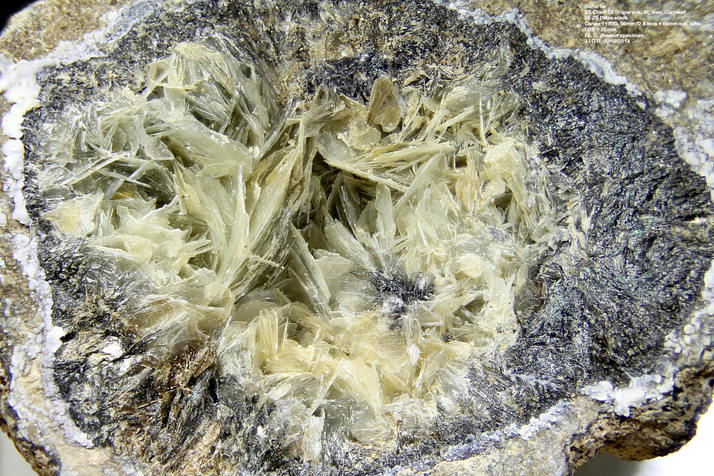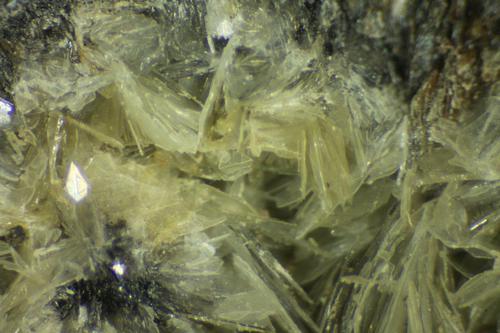Abuhrite has been found almost exclusively growing on tin ingots in old to ancient ship wrecks in the ocean. One would expect that tin ingots would oxidize in seawater and form romarchite or hydroromarchite. These minerals are also found on corroded tin. Griffin et al. (1977) consider that abhurite formed while organic material in the ship were still decaying, as this would have temporarily altered the pH/EH sufficiently to form tin chloride (abhurite) rather than tin oxide (romarchite). Nature is quite fascinating.
Some mineralogists point out that technically these specimens are "artifacts" and not real minerals because they were not formed naturally but on tin that was refined by man. If anyone bothers to send a formal proposal to IMA, they probably would discredit it, I however, would put one in my mineral collection.
“…we did obtain two tin ingots from the shipwreck, , one of which has been blistered by the sea, and which contains large crystals of abhurite. The ingot weighs 28 pounds and is about 15” long with a major blister about 3” in diameter. The rough interior of this blister contains a group of slightly milky, tabular, extremely thin hexagonal abhurite crystals up to about ¼ inch in diameter…The interior of the blister consists of gray altering tin in which there is at least one arcuate band of somewhat indistinct abhurite crystals. …One interesting point about these ingots, which has interested the biota people here who have also looked at them is that we know exactly how long they have been in the sea. The ship sank on 21 July 1885 (at 4.15am no less!!!) and the first ingots were recovered in 1994, making a total of 109 years in the briny.”1
The steamer SS Liverpool was carrying tin ingots from Cornwall and sank in 1863 after colliding with the barque Laplata, which had just left Liverpool on its way to Lima, Peru. The tin ingots command higher prices amongst collectors of historical artefacts than abhurite specimens would sell for to mineral collectors.
This locality is also the site of a ship wreck. “They are up to 5 mm long. We have a pure crystal aggregate that measures 0.5 x 1 x 3.5 cm. Our museum has eight specimens plus numerous small fragments. Our largest specimen (which is on display) measures 1.5 x 9 x 19 cm and is almost covered by abhurite crystals on one side (9 x 19 cm) The Norwegian Maritime Museum probably has more material…”1 These abhurite crystals grew on tin dinner ware(plates etc.) rather than on tin ingots like the other two localities here mentioned.
This type locality is about 30 km north of Jiddah, Saudi Arabia. If you want to collect some there, at the very least you are going to need some diving equipment and most likely an archeological digging permit from the government. This is the type locality for the species and the mineral was identified “…as blisterlike protuberances that formed as a corrosion product of tin ingots recovered from the cargo of a sunken ship, wrecked possibly 100 years ago,…The mineral occurs as cryptocrystalline crusts and as platy hexagonal crystals that average 1.5 mm in diameter…Crystals are platy to tabular on hexagonal (0001, twinned on (0001), and have rhombohedral forms…Associated minerals are romarchite, kutnohorite, and aragonite. Specimens of abhurite are in the Smithsonian Institution, Washington, DC and in the Royal Ontario Museum, Toronto, Ontario.”1 “As thin, six-sided crystals, platy to tabular…, to 2 mm…”2 The Handbook of mineralogy cites two other shipwrecks, one near Hidra, Norway and one at St. Ives, Cornwall, England as other localities.
Thanks to Gunnar Raade (2003), curator of the University of Oslo Mineralogical-Geological Museum , and to Peter Tandy (2001) Curator of Minerals, British Museum of Natural History for valuable information regarding abhurite from the "Hidra Shipwreck" and SS Cheerful respectively.
Some mineralogists point out that technically these specimens are "artifacts" and not real minerals because they were not formed naturally but on tin that was refined by man. If anyone bothers to send a formal proposal to IMA, they probably would discredit it, I however, would put one in my mineral collection.
England
SS Cheerful wreck site, Cornwall, England, UK
“…we did obtain two tin ingots from the shipwreck, , one of which has been blistered by the sea, and which contains large crystals of abhurite. The ingot weighs 28 pounds and is about 15” long with a major blister about 3” in diameter. The rough interior of this blister contains a group of slightly milky, tabular, extremely thin hexagonal abhurite crystals up to about ¼ inch in diameter…The interior of the blister consists of gray altering tin in which there is at least one arcuate band of somewhat indistinct abhurite crystals. …One interesting point about these ingots, which has interested the biota people here who have also looked at them is that we know exactly how long they have been in the sea. The ship sank on 21 July 1885 (at 4.15am no less!!!) and the first ingots were recovered in 1994, making a total of 109 years in the briny.”1
SS Liverpool wreck site, Isle of Anglesey, Wales, UK
The steamer SS Liverpool was carrying tin ingots from Cornwall and sank in 1863 after colliding with the barque Laplata, which had just left Liverpool on its way to Lima, Peru. The tin ingots command higher prices amongst collectors of historical artefacts than abhurite specimens would sell for to mineral collectors.
Norway
Wreck site, Hidra, Flekkefjord, Agder, Norway
This locality is also the site of a ship wreck. “They are up to 5 mm long. We have a pure crystal aggregate that measures 0.5 x 1 x 3.5 cm. Our museum has eight specimens plus numerous small fragments. Our largest specimen (which is on display) measures 1.5 x 9 x 19 cm and is almost covered by abhurite crystals on one side (9 x 19 cm) The Norwegian Maritime Museum probably has more material…”1 These abhurite crystals grew on tin dinner ware(plates etc.) rather than on tin ingots like the other two localities here mentioned.
Saudi Arabia
Sharm Abhur Cove, Jiddah (Jeddah), Mecca Region, Saudi Arabia
This type locality is about 30 km north of Jiddah, Saudi Arabia. If you want to collect some there, at the very least you are going to need some diving equipment and most likely an archeological digging permit from the government. This is the type locality for the species and the mineral was identified “…as blisterlike protuberances that formed as a corrosion product of tin ingots recovered from the cargo of a sunken ship, wrecked possibly 100 years ago,…The mineral occurs as cryptocrystalline crusts and as platy hexagonal crystals that average 1.5 mm in diameter…Crystals are platy to tabular on hexagonal (0001, twinned on (0001), and have rhombohedral forms…Associated minerals are romarchite, kutnohorite, and aragonite. Specimens of abhurite are in the Smithsonian Institution, Washington, DC and in the Royal Ontario Museum, Toronto, Ontario.”1 “As thin, six-sided crystals, platy to tabular…, to 2 mm…”2 The Handbook of mineralogy cites two other shipwrecks, one near Hidra, Norway and one at St. Ives, Cornwall, England as other localities.
Acknowledgements
Thanks to Gunnar Raade (2003), curator of the University of Oslo Mineralogical-Geological Museum , and to Peter Tandy (2001) Curator of Minerals, British Museum of Natural History for valuable information regarding abhurite from the "Hidra Shipwreck" and SS Cheerful respectively.
Revisons
Revision History | |||||||||||||||
|
References
Article has been viewed at least 413 times.






















